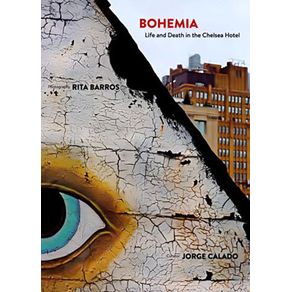Sinopse
When it was built in the early 1880s Chelsea Association Building was the tallest and largest building in New York. Reinvented as a residential hotel in 1905, soon became the unofficial home of American arts and an unholy Mecca for artists from around the world. The Portuguese photographer Rita Barros lived in Chelsea for more than three decades, occupying the apartment # 1008 where, in the 1960s, Arthur C. Clarke wrote 2001: A Space Odyssey. The life of the place, its neighbors exotic, and hisown persona are the subject of their work. An architectural and cultural landmark since 1966, the Hotel Chelsea was sold in 2011 and is currently being gutted by real estate companies. Instead of watching helplessly the destruction, Barros point thecamera at what is happening around you and documents the fall of Chelsea. Bohemia can be read as a parable of life and death - a nostalgic and ironic vision of an uninhibited space of freedom and creativity that once flourished in the middle of the modern city. Quando foi construído no início dos anos 1880 o Chelsea Association Building era o prédio mais alto e maior em Nova Iorque. Reinventado como um hotel residencial, em 1905, logo se tornou o lar não-oficial das artes americanas e uma Meca profana para artistas de todo o mundo. A fotógrafa portuguesa Rita Barros viveu no Chelsea por mais de três décadas, ocupando o Apartamento # 1008 onde, na década de 1960, Arthur C. Clarke escreveu 2001: Uma Odisseia no Espaço. A vida do lugar, os seus exóticos vizinhos, e sua própria persona são o tema de seu trabalho. Constituindo um marco arquitectónico e cultural desde 1966, o Hotel Chelsea foi vendido em 2011 e atualmente está a ser esventrado por empresas imobiliárias. Em vez de assistir impotente à sua destruição, Barros aponta a câmara para o que está acontecer ao seu redor e documenta a queda do Chelsea. Bohemia pode ser lido como uma parábola da vida e da morte - uma visão nostálgica e irónica de um espaço de liberdade e criativida
Ficha Técnica
Especificações
| ISBN | 9789898481368 |
|---|---|
| Subtítulo | LIFE AND DEATH IN THE CHELSEA HOTEL |
| Pré venda | Não |
| Peso | 420g |
| Autor para link | CALADO JORGE |
| Livro disponível - pronta entrega | Não |
| Dimensões | 24 x 17 x 1.1 |
| Idioma | Inglês |
| Tipo item | LIVRO IMPORTADO ADQ MERC INTERNO |
| Número de páginas | 136 |
| Número da edição | 1ª EDIÇÃO - 2015 |
| Código Interno | 759234 |
| Código de barras | 9789898481368 |
| Acabamento | PAPERBACK |
| Autor | CALADO, JORGE |
| Editora | IST PRESS ** |
| Sob encomenda | Não |
| Fotógrafo | BARROS, RITA |



